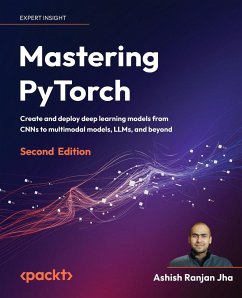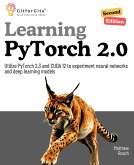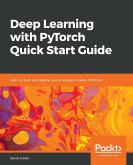Master advanced techniques and algorithms for machine learning with PyTorch using real-world examples Updated for PyTorch 2.x, including integration with Hugging Face, mobile deployment, diffusion models, and graph neural networks Purchase of the print or Kindle book includes a free eBook in PDF formatKey Features: - Understand how to use PyTorch to build advanced neural network models - Get the best from PyTorch by working with Hugging Face, fastai, PyTorch Lightning, PyTorch Geometric, Flask, and Docker - Unlock faster training with multiple GPUs and optimize model deployment using efficient inference frameworksBook Description: PyTorch is making it easier than ever before for anyone to build deep learning applications. This PyTorch deep learning book will help you uncover expert techniques to get the most from your data and build complex neural network models. You'll build convolutional neural networks for image classification and recurrent neural networks and transformers for sentiment analysis. As you advance, you'll apply deep learning across different domains, such as music, text, and image generation using generative models, including diffusion models. You'll not only build and train your own deep reinforcement learning models in PyTorch but also learn to optimize model training using multiple CPUs, GPUs, and mixed-precision training. You'll deploy PyTorch models to production, including mobile devices. Finally, you'll discover the PyTorch ecosystem and its rich set of libraries. These libraries will add another set of tools to your deep learning toolbelt, teaching you how to use fastai for prototyping models to training models using PyTorch Lightning. You'll discover libraries for AutoML and explainable AI (XAI), create recommendation systems, and build language and vision transformers with Hugging Face. By the end of this book, you'll be able to perform complex deep learning tasks using PyTorch to build smart artificial intelligence models.What You Will Learn: - Implement text, vision, and music generating models using PyTorch - Build a deep Q-network (DQN) model in PyTorch - Deploy PyTorch models on mobile devices (Android and iOS) - Become well-versed with rapid prototyping using PyTorch with fast.ai - Perform neural architecture search effectively using AutoML - Easily interpret machine learning models using Captum - Design ResNets, LSTMs, and graph neural networks (GNNs) - Create language and vision transformer models using Hugging FaceWho this book is for: This deep learning with PyTorch book is for data scientists, machine learning engineers, machine learning researchers, and deep learning practitioners looking to implement advanced deep learning models using PyTorch. This book is ideal for those looking to switch from TensorFlow to PyTorch. Working knowledge of deep learning with Python is required.
Bitte wählen Sie Ihr Anliegen aus.
Rechnungen
Retourenschein anfordern
Bestellstatus
Storno









